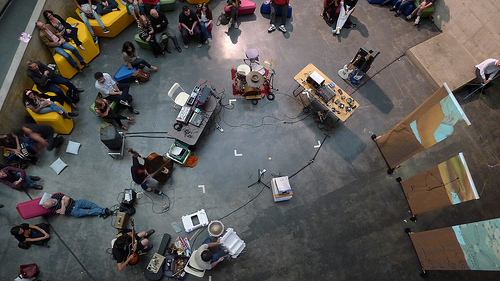Tweaking tradition with Minor Empire and Thingamajigs
There are as many roads down the path of “world music” as there are countries represented within that nebulous category. And while there’re still plenty of purists adhering strictly to the musical traditions of the past, it’s just as common for today’s world musicians to use those traditions as a kind of jumping-off point for their compositions, in much the same way that the 12-bar blues have been the foundation for numerous offshoots of “American” music.
A good example of this conscious hybridization between past and present, old word and new, is Toronto-based Turkish-Canadian combo Minor Empire, who blend sinuous Eastern folk tunes with Western jazz-jam, desert rock, and pulsing electronica, providing multiple entrance points to their specific sound.
In an intimate show at Yoshi’s San Francisco, the touring band seemed simultaneously dwarfed by the lofty ceiling and genteel table seating and yet musically unconfined as they introduced their set with building blocks of drone, guitar, bass, percussion, and kanun (a kind of zither), creating an elegant setting for the jewel-like vocals of Ozgu Ozman. Gracious and grounded, Ozman took time to translate some of the lyrics later in the set, but the first songs were left tantalizingly ambiguous, layering different kinds of familiarity on top of one another.
Plaintive traditional melodies of love and loss, an undercurrent of electronic glitch, the occasional flourish of Calexico-style guitar riffs and funky bass lines, the insistent twinned rhythms of the kanun and the doumbek. The resultant mélange sounded to my ears a little like Wovenhand’s Eastern-tinged album The Threshing Floor, a little like Baba Zula, an alt-jazz/psychedelic combo from Istanbul, and a lot like a band I’d want to get to know better in slightly less refined surroundings — a sweatier nightclub, perhaps, or a sunlit outdoor stage. A space where not just the ears could be transported by the complex compositions, but the body entire.
Architecture favored Thingamajigs Performance Ensemble better at the Berkeley Art Museum on Friday, where a trio of trios performed experimental music in the cavernous atrium of Gallery B. Although, like Yoshi’s, the ceiling soared far above the huddle of intently concentrating musicians, and the room sprawled far beyond the tight confines of their performance area, they managed to fill in the gaps with their judicious addition of a multimedia dimension. From the ground to the lofty balconies above, three long scrolls marked with arcane symbols, half-recognizable words, and morse-code like rhythm tablature were slowly unfurled before each trio in sedate counterpoint to the deliberately atonal improvisations.
Live video projections of a poet at work (Sasha Hom) further helped to fill the empty spaces above, while below the oddience was encouraged to shift position and wander the wings during the concert. Scattered about the room, brightly-colored, padded shapes — trapezoids and triangles — designed by Rebar served as seating and further added another playful visual aspect to the event.
Using a variety of traditional instruments in some very non-traditional ways, Thingamajigs has been experimenting with the creation of differently-structured sound since the mid-nineties. It’s an artform with a long lineage, and as such cannot be championed as an entirely new concept. But given the rare confluence of disparate factors in any given concert — space, spectators, ever-evolving interpretations of the potential locked within each instrument and each composition — every performance is in itself as new and as fleeting as the first few moments of a half-remembered dream. Thingamajigs will be in residence at BAM through August 16; check out the website for ways to dream along.

